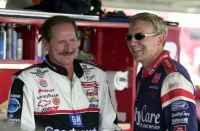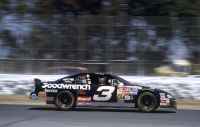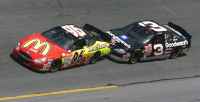 |
  |
|
|
|
|
|
|





|
|
Senna and Earnhardt, RIP Story by Steve Dean, pictures by Mike Veglia & Ford - 03 March 2001. Everyone says that the good times go by in a flash. By the time we realize the fun we've had, it's over. It's one of life's cruel ironies. Perhaps it is a natural check and balance of life. Too much of a good thing throws everyday life into chaos. Maybe that is the logic - maybe, but to me, it seems rather cold. That could, possibly, explain why the bad times come from nowhere, knock us over the head, and quickly disappear; with the swiftness of a lightning strike, tragedy doesn't hit us as much as it leaves us. A death to a family member, a friend, or an acquaintance is such a shock because life still moves on. It's almost as if that person missed the train to the rest of life. All the rest of us can do is look back towards that last train station and wave. Indeed, the bad times move at the same speed as the good. Maybe there is some logic to THAT. Dale Earnhardt, Sr. died today at Daytona Beach, Florida. He was 49 years young. As quick as the good times fly past us, the bad times are just as swift. Before we could comprehend the racing year had begun, a legend was taken from us. In typical Earnhardt fashion, he took it all the way, to the last turn, of the last lap of the 2001 Daytona 500. It was then, as fast as Michael Waltrip was heading to the checkered flag, that Earnhardt left us. Two hours after the race concluded, I heard the news. It brought back a tidal wave of bad memories. May 1 1994, Imola, Italy. On that day, the other great driver of the late twentieth century, Ayrton Senna, lost his life in a Formula One racecar. Today, I have the same feeling as I had on that early May morning - a feeling of closure. Whether or not I, or we, were ready, the end had come. To me, Senna and Earnhardt were remarkably alike. When I started following racing in 1990, both Senna and Earnhardt were at the top of their games. Both seemed to be able to win at will. I've always loved the underdog, so, naturally, I hated both of them. Senna and Earnhardt could turn a race into an exhibition. That's great, if you're one of their fans, but if you love to see a bunch of drivers fighting for a win, you were lost. Senna and Earnhardt made it seem too easy, and damn, it's easy to hate a winner. Yet, as I expanded my knowledge of racing, it was impossible to ignore the majesty of Senna and Earnhardt. As I began to ignore playing favorites, I slowly began to appreciate what made these two greats so special. If you appreciate the very concept of motor racing, you revered how serious these men were, when they "got their groove on". Both men have been crucified (at times rightly so) for their race tactics. But you can't deny their undeniable pursuit of being the best at what they did. You could hate Senna or Earnhardt, but they were the best. That was FACT. It is said that the truth can be ugly, yet in Senna and Earnhardt's case, the truth was often a beautiful display of the law of the jungle. Until May 1 1994, and today. The law of the jungle also ignores favorites. My true love is Formula One, but when it comes right down to it, I love racing, period. I'd much prefer to turn on Speedvision, and see sixteen and seventeen year-olds racing go-karts than watch HBO. I don't watch too much NASCAR anymore. I only watch the "big" races and the road courses that NASCAR runs on. Today, watching the 500, I raised my diet drink to the TV and gave a salute. Seeing the camera view from the Budweiser blimp demonstrated what an unbelievable job these drivers did, at these speeds, in window-to-window traffic. Road-racing fans may decry the apparent simplicity of racing on a track with four turns, all in the same direction, but real eyes see what special skills are needed for a 185-MPH rush-four-hour. Simply incredible! As incredible as the 18-car pile-up was, the truly incredible reality of the race was the fact that there was only one, such pile-up. Then, of course, there was the last lap. As I do during Formula One races, I had a pen and pad, to make some notes of the race. For this race, as it turned out, I only wrote down four brief notes - all from the very beginning of the race. They were as follows:
$11.049,049 - purse
DE (Dale Earnhardt) 34 victories at Daytona As the race concluded, Fox replayed Earnhardt's crash. It was a hard hit to the concrete. Not completely head-on, but damn close. Sterling Marlin's Dodge tapped Earnhardt; just enough to set Earnhardt's rear wheels loose. Just after he spun towards the infield, Earnhardt's Chevy took a hard swipe towards the right, straight up the banking, into the concrete wall. At first, I thought it was a serious hit, but certainly not a fatal one. The driver that Earnhardt took with him during the crash, Ken Schrader, was seen limping out of his car, towards Earnhardt's, to check on his buddy. Afterwards, Schrader was interviewed by the Fox crew and asked about Earnhardt. He said he went to check on Earnhardt but got out of the way when the paramedics arrived. I thought nothing of this, until afterwards. After the victory lane celebrations concluded, that same Budweiser blimp showed a birds-eye view of the ambulance taking Earnhardt to the Halifax Hospital two miles away. Driving through empty streets - as if there was no rush to reach the destination. I thought nothing of this, until afterwards. I was curious about Earnhardt's condition as the race coverage concluded, but none was available that I was aware of. I went about my day. Congratulations, Michael Waltrip. Then, a couple of hours later, I switched the TV back on. The news was in - Dale Earnhardt, Sr. dead at 49. Instantly, I thought back to May of 1994. The best was gone. And it was over so quick. I think nature, God, who or whatever, makes these bad times as short as the good times because of the fragile nature of human beings. I don't know whether or not too much of a good thing is a bad thing, but deaths like Senna's and Earnhardt's are more than I can handle. Maybe the law of the jungle has a hidden, soft side. Maybe that's why these deaths are over before we even realize what is going on. There's no time like the present; so let's mourn and thank the stars it wasn't us. That's what it comes down to, doesn't it? That's what attracts the masses to racing anyway, isn't it, the crashes? Meanwhile, the true racing lovers, we, say goodbye to a great foe, a great hero... a champion. Somewhere, if you believe in the afterlife, is a circuit. On that circuit, certainly, Ayrton Senna is on the pole. Somewhere in the middle of the pack is one, Dale Earnhardt. As the race starts, Senna is off, stretching his race legs. As the race leads on, Senna opens up a comfortable lead. As the race hits the two-thirds mark, Senna looks into his mirrors. All clear and...... wait, there's a black car appearing in the distance. Except the distance rapidly begins to diminish. As the black car gets larger in Senna's mirrors, Senna can clearly see a driver with a half-helmet, and black goggles. Who the hell? Senna is pushing hard now, harder than if Mansell, Prost, or Schumacher were close in tail. He swears he sees a wide grin amid a wide moustache. Who is this guy? Senna figures he will scratch his wheels with this guy when he pulls even, but when he pulls even, the wide grin is wider, looking eye to eye with the Brazilian master. Just where he ought to be. Here's to you, Dale, may there be nary a restrictor plate on your plate, and may you give Jimmy Clark and Ayrton Senna a friendly "nudge" to remind them that the Intimidator has arrived. |